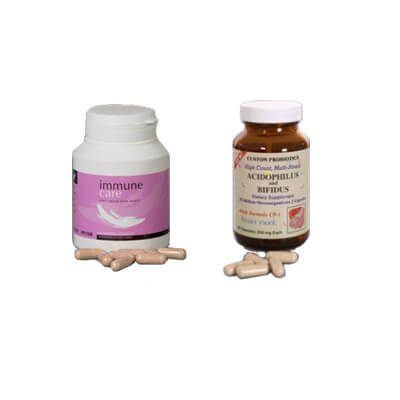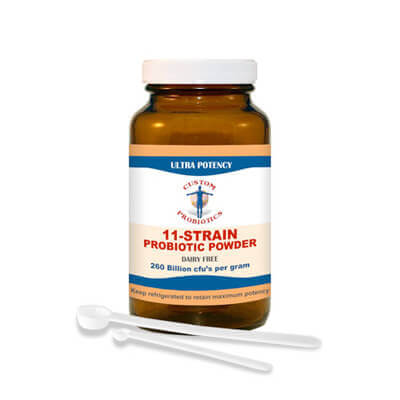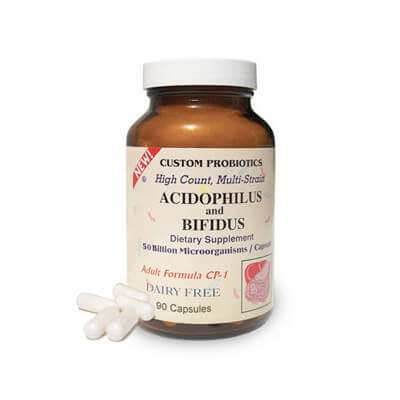- Sorry, this product cannot be purchased.
Diverticulitis Pack
£88.45
The Diverticular Pack comprises one bottle of Custom Probiotics CP-1 and one bottle of Immunecare Lactoferrin Xtra 30 caps..
The use of a natural antibiotic such as Lactoferrin is an obvious choice to keep the colon healthy. Lactoferrin is a first line defensive protein that lines the mucosal membranes of the body, including the gut mucosa. Its job is to keep bad bacteria and pathogens under control, especially in the gut, so it is a natural answer to reducing infections in the gut.
Probiotics will also reduce the risk of periods of infection in the colon due to their antibiotic effect. Beneficial bacteria produce a number of antibiotic compounds that kill off bad bacteria and yeast organisms, thereby reducing the ongoing risk of infection in diverticular pockets. A high count probiotic such as CP-1 is ideal for this role.
Out of stock
Detailed Description
Many people have small pouches in their colon that bulge outward through weak spots, like an inner tube that pokes through weak places in a tyre. Each pouch is called a diverticulum; pouches (plural) are called diverticula. The condition of having diverticula is called diverticulosis. The condition becomes more common as people age. About half of all people over the age of 60 have diverticulosis, and of these, around 90% are asymptomatic.
When the pouches become infected or inflamed, the condition is called diverticulitis. This happens in 10 to 25 percent of people with diverticulosis. Diverticulosis and diverticulitis are also called diverticular disease, but a more accurate term is ‘colonic diverticulosis’. Initial treatment of diverticulitis is by administration of antibiotics such as metronidazole or ciprofloxacin. Unfortunately these disrupt the bowel flora on an ongoing basis, reducing immunity in the gut, and making further periods of infection likely.
The use of a natural antibiotic such as Lactoferrin is an obvious choice to keep the colon healthy. Lactoferrin is a first line defensive protein that lines the mucosal membranes of the body, including the gut mucosa. Its job is to keep bad bacteria and pathogens under control, especially in the gut, so it is a natural answer to reducing infections in the gut.
Probiotics will also reduce the risk of periods of infection in the colon due to their antibiotic effect. Beneficial bacteria produce a number of antibiotic compounds that kill off bad bacteria and yeast organisms, thereby reducing the ongoing risk of infection in diverticular pockets. A high count probiotic such as CP-1 is ideal for this role.
The combination of Lactoferrin Xtra and CP-1 helps to keep your colon healthy, and immunity in the gut at a high level, resulting in fewer pathogens and resulting risk of infection.
Although not proven, the dominant theory is that a low-fibre diet is the main cause of diverticular disease. The disease was first noticed in the United States in the early 1900s. At about the same time, processed foods were introduced into the American diet. Many processed foods contain refined, low-fibre flour. Unlike whole-wheat flour, refined flour has no wheat bran.
Diverticular disease is common in developed or industrialised countries—particularly the United States, England, and Australia—where low-fibre diets are common. The disease is rare in countries of Asia and Africa, where people eat high-fibre vegetable diets.
Constipation makes the muscles strain to move stool that is too hard. It is the main cause of increased pressure in the colon. This excess pressure might cause the weak spots in the colon to bulge out and become diverticula. Where there is no inflammation present, but the patient suffers from constipation, an increase in fibre, use of peppermint capsules, and an osmotic laxative may be useful.
Diverticulitis occurs when diverticula become infected or inflamed. Doctors are not certain what causes the infection. It may begin when stool or bacteria are caught in the diverticula. An attack of diverticulitis can develop suddenly and without warning.
Most people with diverticulosis do not have any discomfort or symptoms. However, symptoms may include mild cramps, bloating, and constipation. Other diseases such as irritable bowel syndrome (IBS) and stomach ulcers cause similar problems, so these symptoms do not always mean a person has diverticulosis. You should visit your doctor if you have these troubling symptoms.
Diverticulitis
The most common symptom of diverticulitis is abdominal pain. The most common sign is tenderness around the left side of the lower abdomen. If infection is the cause, fever, nausea, vomiting, chills, cramping, and constipation may occur as well. The severity of symptoms depends on the extent of the infection and complications.
Diverticulitis can lead to bleeding, infections, perforations or tears, or blockages. These complications always require treatment to prevent them from progressing and causing serious illness.
Bleeding
Bleeding from diverticula is a rare complication. When diverticula bleed, blood may appear in the toilet or in your stool. Bleeding can be severe, but it may stop by itself and not require treatment. Doctors believe bleeding diverticula are caused by a small blood vessel in a diverticulum that weakens and finally bursts. If you have bleeding from the rectum, you should always see your doctor.
If you have any questions about our products, then please email us at [email protected] or call our Free Helpline 0044 208 901 6477; from the UK call 0208 9016477






Reviews
There are no reviews yet.